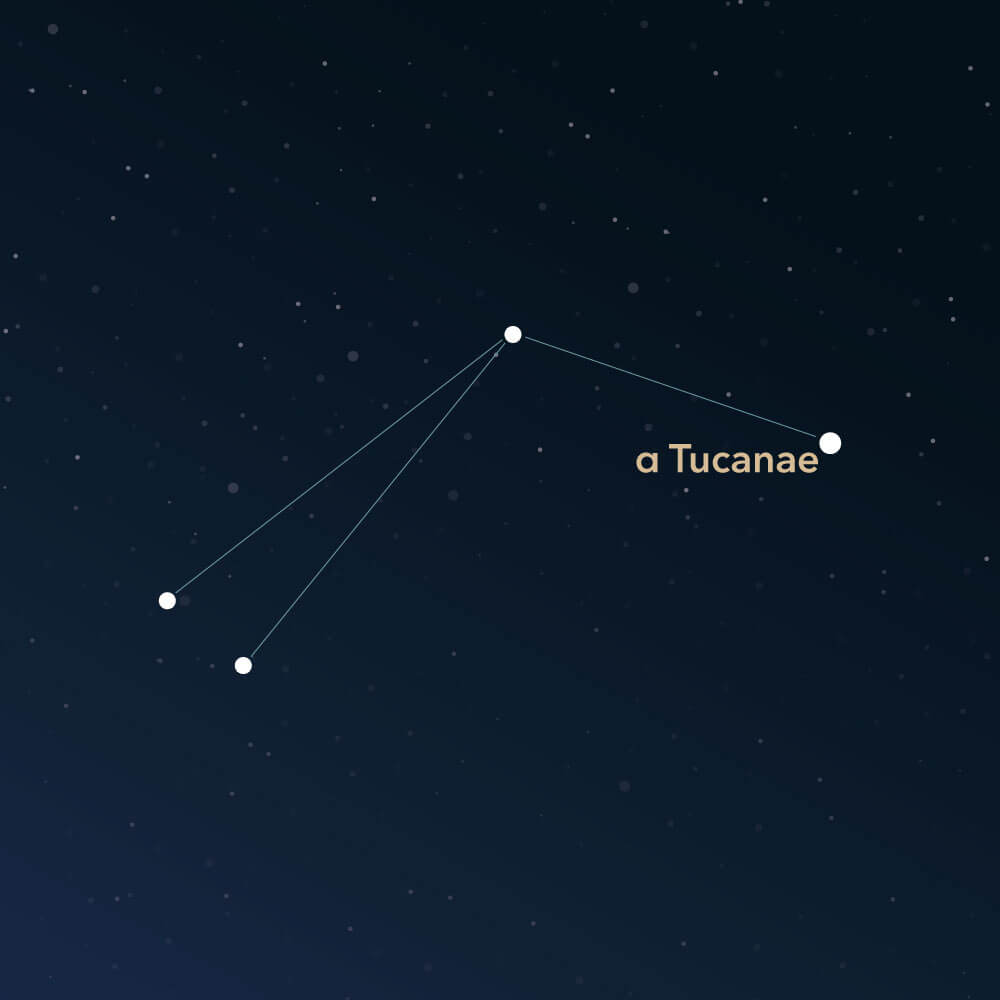The constellation Tucana
Caratteristiche
- Nome latino
- Tucana
- Emisfero
- Emisfero meridionale
- Visibilità
- August - November
- Area
- 295 deg²
- Stella più luminosa
- α Tucanae (HIP number 110130)
- Specialità
- Globular clusters, open star clusters, galaxy, gas nebula

The Tucana symbolizes a toucan, a South American bird. It is an inconspicuous constellation of the south and was first defined by Dutch sailors in the late 16th century. The sky area has some interesting deep-sky objects, with two particularly noteworthy.
Hemisphere, visibility, and area
The Tucana constellation lies in the southern hemisphere and can be seen from the entire southern half of the earth. North of the equator, it is only completely visible up to the 15th parallel. This corresponds roughly to regions such as the Cape Verde Islands on the west coast of Africa, Guatemala City in Guatemala, or the state of Goa in India.
The best time to observe the constellation is from August to November, with November giving the best conditions. It covers an area of around 295 square degrees and is ranked 48th in size compared to all 88 constellations.
In sky maps, Tucana is always visualized with the brightest stars, usually connected to form a crooked line. In many illustrations, a branch is also drawn to another star. The most shining star of all is α Tucanae (Alpha Tucanae), which is a binary star system with an apparent magnitude of roughly 2.8. Its distance from earth is estimated to be around 200 light-years.
To find Tucana in the night sky, it is helpful to orient oneself to the neighboring constellations. To the north lies the large Eridanus, the Phoenix, and the Grus. To the east, the Indus is adjacent, and to the south, the Octans. The Hydrus meanders to the west.
Specialties in the constellation
In the area of Tucana, there are several nebulous objects, including globular clusters, an open star cluster, a galaxy, and a gas nebula.
The globular cluster with the catalog number NGC 104, also known as "47 Tucanae," is the second brightest globular cluster in the entire night sky with an apparent magnitude of about 4.9. Its size is approximately two-thirds of the diameter of the full moon, and its distance from earth is estimated to be 15,000 light-years. NGC 104 can already be seen as a nebulous spot with the naked eye, and individual stars can be observed with a medium-sized telescope.
In addition to NGC 104, the interesting galaxy NGC 292 is also located in the area of Tucana. It is especially known as the "Small Magellanic Cloud" and is a small satellite galaxy of the Milky Way, located at a distance of around 200,000 light-years. NGC 292 contains a series of star clusters and nebulae that can be observed with small telescopes.

Both objects are located at the border of the constellation of Hydrus.
History
The constellation Tucana was described around 1600 by Dutch sailors on their way to the legendary Spice Islands (now Indonesia). In 1595, they set out under the leadership of Pieter Dirkszoon Keyser and Frederick de Houtman to create new trade relations. For the long sea voyage, they were commissioned by the astronomer Peter Plancius to collect data on numerous stars.
Thus, they eventually measured the coordinates of over 150 stars. As a result, they defined several new constellations, including Tucana, which initially received the name "Den Indiaenschen Exster, op Indies Lang ghenaemt."
About three years after the arduous journey, which only a part of the crew survived, Peter Plancius included the constellation in his star maps. Three years later, the German astronomer Johann Bayer transferred the constellation to his star atlas, "Uranometria." However, he changed the name to "Toucan" because he could not imagine an exotic bird under the original name.
PubblicatoLeggi altri articoli interessanti

An overview of all 88 constellations
Learn more about all 88 constellations and read interesting information about the mythology, visibility, and features.

App Planetario
Discover the night sky with our planetarium app!
Available for iOS and Android.

Dai un nome a una stella nella costellazione Toucan
Name a star in a constellation and create something that lasts for eternity.